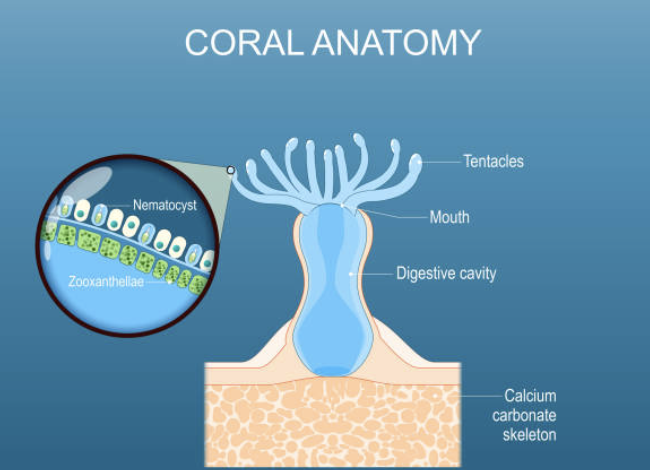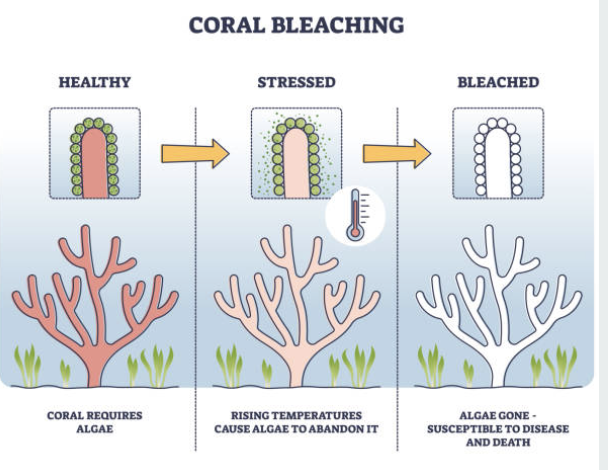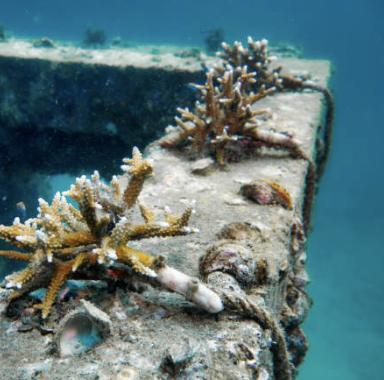Coral Reefs
Corals can be found throughout the oceans, from deep, cold waters to shallow, tropical waters. Shallow coral reefs have optimal growth rates in warm water ranging from 70–85° F (21–29° C). Coral reefs can be found at depths exceeding 91 m (300 ft), but reef-building corals generally grow best at depths shallower than 70 m (230 ft). The most prolific reefs occupy depths of 18–27 m (60–90 ft), though many of these shallow reefs have been degraded. Corals also need salt water to survive, so they also grow poorly near river openings with fresh water runoff. Other factors influencing coral distribution are availability of hard-bottom substrate, the availability of food such as plankton, and the presence of species that help control macroalgae, like urchins and herbivorous fish.
Corals are in fact animals (not a plant!) that fall under the phylum Cnidaria and the class Anthozoa. They are relatives of jellyfish and anemones. Corals can exist as individual polyps, or in colonies and communities that contain hundreds to hundreds of thousands of polyps. For example, brain corals consist of colonies of many individual polyps; each individual polyp averages 1-3 mm in diameter. Corals can be divided into two groups: hard coral and soft coral. Hard corals, also known as stony coral, produce a rigid skeleton made of calcium carbonate (CaCO3) in crystal form called aragonite, with reef-building capabilities. Alternatively, soft corals, including sea fans, do not produce a rigid calcium carbonate skeleton and do not form reefs, though they may be present in a reef ecosystem.
example, brain corals consist of colonies of many individual polyps; each individual polyp averages 1-3 mm in diameter. Corals can be divided into two groups: hard coral and soft coral. Hard corals, also known as stony coral, produce a rigid skeleton made of calcium carbonate (CaCO3) in crystal form called aragonite, with reef-building capabilities. Alternatively, soft corals, including sea fans, do not produce a rigid calcium carbonate skeleton and do not form reefs, though they may be present in a reef ecosystem.
Most reef-building corals have a mutually beneficial relationship with a microscopic unicellular algae called zooxanthellae that lives within the cells of the coral’s gastrodermis. As much as 90 percent of the organic material the algae manufacture photosynthetically is transferred to the host coral tissue. In addition to the symbiotic relationship with algae, most corals capture and consume live prey ranging from microscopic zooplankton to small fish, depending on coral size. Using its tentacles that extend outside it body, the coral with utilize it nematocysts, or stinging cells, to stun and kill its prey before passing it to its mouth. Once the food has been digested, the waste is expelled from the same opening.
Corals are unique in that they are capable of reproducing both sexually and asexually. Sexual reproduction is the more common method and can be performed in two ways: broadcast spawning or brooding. Broadcast spawning consists of both male and female coral expelling massive amounts of gametes (eggs and sperm) into the water column during synchronized events. Brooding is similar to broadcast spawning, except only the male gametes are released into the water column. Coral sperm is negatively buoyant once released and hopefully will be carried by ocean currents to female coral where they will fertilize the egg cells of the female coral.
Coral reefs face many threats from local sources, including:
- Physical damage or destruction from coastal development, dredging, quarrying, destructive fishing practices and gear, boat anchors and groundings, and recreational misuse (touching or removing corals).
- Pollution that originates on land but finds its way into coastal waters. There are many types and sources of pollution from land-based activities, for example:
- Sedimentation from coastal development, urban stormwater runoff, forestry, and agriculture
Sedimentation has been identified as a primary stressor for the existence and recovery of coral species and their habitats. Sediment deposited onto reefs can smother corals and interfere with their ability to feed, grow, and reproduce. - Nutrients (nitrogen and phosphorous) from agricultural and residential fertilizer use, sewage discharges (including wastewater treatment plants and septic systems), and animal waste
Nutrients are generally recognized as beneficial for marine ecosystems; however, coral reefs are adapted to low nutrient levels; so an excess of nutrients can lead to the growth of algae that blocks sunlight and consumes oxygen corals need for respiration. This often results in an imbalance affecting the entire ecosystem. Excess nutrients can also support growth of microorganisms, like bacteria and fungi, that can be pathogenic to corals. - Pathogens from inadequately treated sewage, stormwater, and runoff from livestock pens
Although rare, bacteria and parasites from fecal contamination can cause disease in corals, especially if they are stressed by other environmental conditions. Coral disease occurs in healthy ecosystems, but the input of pathogen-containing pollution can exacerbate the frequency and intensity of disease outbreaks. - Toxic substances, including metals, organic chemicals and pesticides found in industrial discharges, sunscreens, urban and agricultural runoff, mining activities, and runoff from landfills
Pesticides can affect coral reproduction, growth, and other physiological processes. Herbicides, in particular, can affect the symbiotic algae (plants). This can damage their partnership with coral and result in bleaching. Metals, such as mercury and lead, and organic chemicals, such as polychlorobiphenyls (PCBs), oxybenzone and dioxin, are suspected of affecting coral reproduction, growth rate, feeding, and defensive responses. - Trash and micro-plastics from improper disposal and stormwater runoff
Trash such as plastic bags, bottles, and discarded fishing gear (also called marine debris) that makes its way into the sea can snag on corals and block the sunlight needed for photosynthesis, or entangle and kill reef organisms and break or damage corals. Degraded plastics and microplastics (e.g., beads in soap) can be consumed by coral, fish, sea turtles, and other reef animals, blocking their digestive tracts and potentially introducing toxics.
- Sedimentation from coastal development, urban stormwater runoff, forestry, and agriculture
- Overfishing can alter food-web structure and cause cascading effects, such as reducing the numbers of grazing fish that keep corals clean of algal overgrowth. Blast fishing (i.e., using explosives to kill fish) can cause physical damage to corals as well.
- Coral harvesting for the aquarium trade, jewelry, and curios can lead to over-harvesting of specific species, destruction of reef habitat, and reduced biodiversity.
Global threats to coral reefs include:
Increased ocean temperatures and changing ocean chemistry are the greatest global threats to coral reef ecosystems. These threats are caused by warmer atmospheric temperatures and increasing levels of carbon dioxide in seawater.
As atmospheric temperatures rise, so do seawater temperatures. This warming causes corals to lose the microscopic algae that produce food that corals need, placing stress on the corals. Without this algae coral also lose their coloration—a condition known as coral bleaching— because the loss of algae reveals the white color of the calcium carbonate structure underlying the polyps. Severe or prolonged bleaching can kill coral colonies or leave them more vulnerable to other threats such as infectious disease.
Other climate impacts, such as sea level rise, increased frequency and intensity of tropical storms, and altered ocean circulation patterns, can also affect coral reefs.
Ocean acidification refers to a change in ocean chemistry in response to the uptake of carbon dioxide from the atmosphere. The amount of carbon dioxide in the atmosphere is in equilibrium with that in seawater, so when atmospheric concentrations increase so do oceanic concentrations. Carbon dioxide entering seawater reacts to form carbonic acid, causing an increase in acidity.
Each year, the ocean absorbs about one-quarter of the carbon dioxide emitted from the burning of fossil fuels (oil, coal, and natural gas). Since the Industrial Revolution, ocean acidity has increased by about 30%, a rate that is more than 10 times what has previously occurred for millions of years. Further, ocean acidity levels are expected to increase by an additional 40% above present levels by the end of this century.
Increases in ocean acidity (measured by lower pH values) reduce the availability of dissolved salts and ions needed by corals to form the calcium carbonate structure. Consequently, coral growth and reef growth can be slowed, with some species affected more than others. If acidication becomes severe, coral skeletons can actually dissolve. On a local level, nutrient enrichment due to run-off from human activities on land can cause increased acidity in coastal waters, exacerbating the effects of ocean acidification.
Florida Coral Conservation Project
The Maritime Aquarium is heavily involved in the AZA’s Florida Reef Tract Rescue Project, in conjunction with FWC and FKNMS. We are currently holding 36 corals of 13 different species as part of a refugium population to safeguard the genetic diversity of the Florida Reef Tract in the face of a devastating disease threat. The reef-building corals in the Caribbean have seen declines up to 90% in recent decades, and this disease (stony coral tissue loss disease, or SCTLD) threatens to kill up to 30% of the surviving corals. Our commitment to this project includes significant devotion of in-kind resources to maintaining these species with the hope to restore them back to the reef once the threat from disease is lessened.
Artificial Reef Exhibit (Next to Sea Turtle Tank)
This exhibit features a large diversity of coral reef fishes and not live corals. 
Below are common coral reef fishes exhibited.
Scientific Name: Common Name
Heniochus acuminatus: Pennant butterflyfish
Chaetodon lunula: Raccoon butterflyfish
Pomacanthus semicirculatus: Blue koran angelfish
Pomacanthus maculosus: Yellowbanded angelfish
Pomacanthus annularis: Bluering angelfish
Centropyge loricula: Flame angelfish
Centropyge flavissimus: Lemonpeel angelfish
Zebrasoma flavescens: Yellow tang
Naso vlamingii: Vlamingii tang
Naso elegans: Elegant unicornfish
Zebrasoma veliferum: Sailfin tang
Zebrasoma desjardinii: Red Sea sailfin tang
Paracanthurus hepatus: Blue tang
Ctenochaetus strigosus: Spotted surgeon
Odonus niger: Pacific black triggerfish
Balistoides conspicillum: Clown triggerfish
Thalassoma grammaticum: Sunset wrasse
Thalassoma lunare: Moon wrasse
Siganus vulpinus: Foxface rabbitfish
Chrysiptera cyanea: Sapphire damselfish
Sphaeramia nematoptera: Pajama cardinalfish
Chromis viridis: Bluegreen chromis
Neocirrhites armatus: Flame hawkfish
Premnas biaculeatus: Spinecheek damselfish
Bodianus axillaris: Coral hogfish
Choerodon fasciatus: Harlequin tuskfish
Naso brevirostris: Shortnosed unicorn tang
Chaetodon lunulatus: Butterflyfish
Caesio cuning: Redbelly yellowtail fusilier
Chromis nitida: Shining puller
Scolopsis bilineatus: Twolined monocle bream
Naso lituratus: Smoothhead unicornfish
Acanthurus olivaceus: Olive surgeon
Pterocaesio digramma: Doublelined fusilier
Dascyllus trimaculatus: Domino damselfish
Acanthurus nigricans: Whitecheek surgeon
Ctenochaetus binotatus: Twospot surgeon
Acanthurus coeruleus: Blue tang surgeon
Ctenochaetus tominiensis: Tomini surgeon
Pacific Reef Exhibit (Across from Jellie Culture Lab)
This exhibit features both live corals and coral reef fishes.
Below are common species exhibited